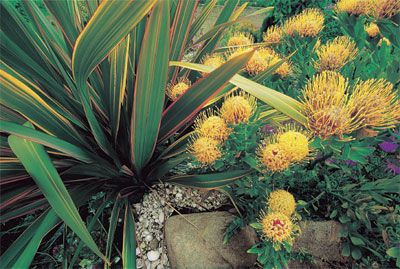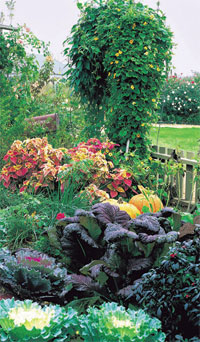Rose Cuttings – August, 2008

Succulents of contrasting size and shape echo each other’s brilliant colors. Photo courtesy of Mike Shoup.
It’s Always About Hue

In a fall setting photographed at the Antique Rose Emporium, blues and purples contrast with oranges and yellows to provide color impact, while vegetables and herbs lend dynamic shapes.
Photo courtesy of Mike Shoup.
In Texas, fall provides the best time to install or reconstruct your garden. Yes, perspective is the cornerstone of garden design and requires that you give careful attention to initial plantings. The eventual relationship of your plants to each other and the hardscape (walkways, fences, etc.) determines the ultimate character and beauty of your landscape. But it is the flower and foliage colors and their juxtaposition to each other that always creates the biggest emotional responses and drama for passersby.
Simply stated, color is but one of several important aspects of garden design. We can’t take structure, form, and scale for granted; they are essential to the foundation of a good garden design. However, color is often the most dramatic part of the garden, especially when plants are in peak bloom.
Green tends to harmonize with other colors and gives a sense of balance to the garden. Gardens are predominantly green throughout the year, giving the viewer a sense of peace. Orange and yellow are stimulating colors. Gardens incorporating these colors are cheerful and bright, creating an illusion of space. These colors are best positioned in front of dark-foliaged plants.
Red hues are exciting and energizing. Red is a passionate color, representing love and anger. It can also create a festive mood. Blue colors are cool and relaxing. Their hues will unify the garden and enhance its size. Pink is a blending color, embellishing other colors. White is pure, divine and clean. Very reflective, white is beautiful on moonlit nights and during early evening strolls through the garden.
Mixing colors can be tricky, but combinations are often more dramatic than a color used singly. Yellow/purple, orange/blue and red/green, all opposites on the color wheel, can provide striking contrasts when used together.
As gardeners, we must harness these components to our best advantage. Put another way, when we talk about hue, we’re talking about a very important part of gardening. Fall is a good time to consider the desired effect.
About the author: Mike Shoup is the owner of the Antique Rose Emporium. Visit their Brenham and San Antonio display gardens for endless ideas on landscaping with roses. To order roses online, visit www.weAREroses.com.

